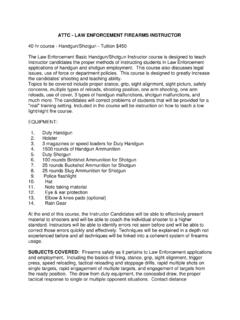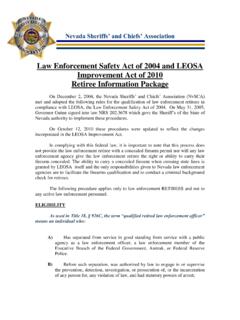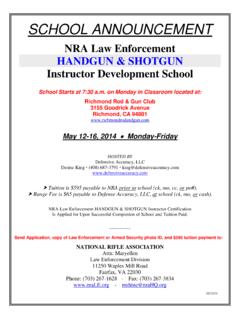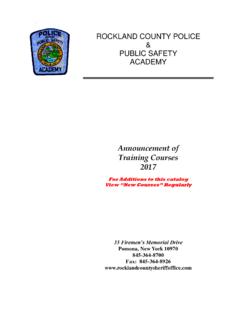Transcription of COUNCIL ON LAW ENFORCEMENT EDUCATION AND ... - Gun …
1 Page 1 COUNCIL ON LAW ENFORCEMENT EDUCATION AND TRAINING LESSON OUTLINE COURSE: FUNCTIONAL AREA: LESSON TITLE: Oklahoma Self Defense Course Firearms Safety, Handling, Shooting DURATION: STUDENT LEVEL: PREPARED BY: 8 Hours Civilian CLEET Training Division METHOD(S) OF PRESENTATION: Lecture, Discussion, Demonstration, Exercises UNIT GOAL: The participants will learn to SAFELY handle and shoot their handguns, and will be familiar with pertinent Oklahoma law. LEARNING GOAL(S) (Lesson): The participant will know, and understand (1) firearm safety (2) the six fundamentals of handgun shooting (3) the correct position for firing a handgun (4) the correct methods and/or positions for firing the handgun (5) the correct loading and unloading techniques (6) the correct procedures for clearing malfunctions (7) the dynamics of ammunition and firing a handgun (8) the provisions of Oklahoma laws relating to self-defense (9) the provisions of the Oklahoma Self Defense Act.
2 ASSESSMENT: Successful completion of this course is achieved when the participant has completed all practical tasks and exercises to the satisfaction of the instructor(s); and a score of 70% or higher has been attained on a multiple choice exam. This exam will be based upon the PERFORMANCE OBJECTIVES: STANDARDS: (1) Eight hours of instructional time is required to complete this course. The time allowed includes classroom and range time. (2) One hundred percent (100%) participation is required. (3) Only handguns firing .45 caliber ammunition and smaller will be accepted. (4) Each participant will display safety with his or her handgun.
3 (5) Each participant will fire two (2) courses of fire (total 50 Rounds). (6) Each participant s handgun will be safety inspected (Rejected if unsafe). (7) Each student must score a minimum of seventy percent (70%) on a written safety examination. (8) Each participant scoring less than 100 percent (100%) on the written safety examination will review the examination, and cover the correct responses for items answered incorrectly. The participant will then be held accountable for one hundred percent (100%) of firearms safety during the range exercise. PERFORMANCE OBJECTIVES: (1) The student will identify the meaning of imminent danger.
4 (2) The student will identify the meaning of the phrase "deadly force." (3) The student will identify the circumstances under which they may carry or transport a firearm. (4) The student will identify prohibited acts using a firearm. (5) The student will display safety with their handgun during classroom instruction. (6) The student will display safety with their handgun during dry firing exercises. (7) The student will display safety with their handgun during familiarization courses of fire. Page 2 STUDENT REFERENCES: INSTRUCTOR REFERENCE: 1. Performance Objectives 1. Title 21 Oklahoma Statutes.
5 2. Handout #1 - Use of Deadly Force Summary 2. Case Law 3. SDA Law Book (available from ) MANDATORY EQUIPMENT: 1. A handgun (.45 caliber or smaller) 2. Eye protection 3. Ear protection 4. Baseball type cap or hat with brim or bill 5. 50 rounds of factory ammunition (NO RELOADS COMMERCIAL OR OTHERWISE) ADDITIONAL RECOMMENDED EQUIPMENT: 1. A container for carrying equipment and ammunition 2. Pencil 3. Notebook paper NOTES: 1. Ammunition may be purchased from the school, the instructor, or from retail outlets. 2. Instructors should advise students of all necessary equipment, , proper ammunition, stapler, staples, targets, and cardboard.
6 COURSE SCHEDULE: See Page 3 Page 3 OKLAHOMA SELF DEFENSE ACT COURSE SCHEDULE PERIOD TIME SUBJECT 1 10 MIN ORIENTATION 2 40 MIN SELF-DEFENSE, USE OF FORCE, CRIMINAL PROVISIONS BREAK 10 MIN 3 50 MIN OKLAHOMA SELF-DEFENSE ACT - TITLE 21 BREAK 10 MIN 4 20 MIN OKLAHOMA SELF-DEFENSE ACT - TITLE 21 5 30 MIN SAFETY- GENERAL, HOME AND STORAGE BREAK 10 MIN 6 30 MIN SAFETY CONTINUED 30 MIN SAFETY EXAM, FIREARMS INSPECTION BREAK 60 MIN LUNCH 7 10 MIN REVIEW SAFETY EXAMINATION 8 40 MIN NOMENCLATURE, CLEANING BREAK 10 MIN 9 50 MIN BASIC SHOOTING FUNDAMENTALS.
7 SIX FUNDAMENTALS OF HANDGUN SHOOTING BREAK 10 MIN 10 50 MIN ERRORS, POSITIONS, HANDLING, LOADING, UNLOADING, CLEARING MALFUNCTIONS, DYNAMICS BREAK 10 MIN 11 30 MIN DRY FIRING 12 50 MIN PRACTICE SHOOTING SESSION BREAK 10 MIN 13 30 MIN FAMILIARIZATION COURSE TOTAL HOURS (INSTRUCTION TIME) ORIENTATION A. Instructional Staff Introductions B. School Rules C. Goals and Objectives Page 4 SELF DEFENSE, USE OF FORCE, and CRIMINAL PROVISIONS A. Constitutional framework 1. All laws related to firearms must be understood within the limitations and rights protected by the Constitution and the Constitution of the State of Oklahoma.
8 2. These are the primary legal documents that define the rights of an individual and the authority of government over those rights. 3. The United States Supreme Court is the institution entrusted with the legal authority to interpret and explain constitutional provisions. These interpretations in the form of case law are the guiding rules that every Court uses to decide questions of law. B. The Second Amendment to the Constitution of the United States of America is the key provision directed to ownership of firearms: 1. A well-regulated militia being necessary to the security of a free state, the right of the people to keep and bear arms shall not be infringed.
9 2. In District of Columbia v. Heller (07-290, 2008), The Supreme Court held that the Second Amendment protects an individual s right to possess a firearm unconnected with service in a militia, and that a federal law that prevents a law-abiding citizen from keeping a firearm in the home for the core purpose of self defense is unconstitutional. 3. In McDonald v. Chicago (08-1521, 2010), The Supreme Court held that, because of the 14th Amendment, the Second Amendment also applies to the States. A State law, or city ordinance, that prevents a law-abiding citizen from keeping a firearm in the home for the core purpose of self defense is unconstitutional.
10 C. The Oklahoma Constitution addresses the extent of a citizen's rights to bear arms as opposed to the state s regulatory power: 1. Oklahoma Constitution Article 2, Section 26: The right of a citizen to keep and bear arms in defense of his home, person, or property, or in aid of the civil power, when thereunto legally summoned, shall never be prohibited; but nothing herein contained shall prevent the legislature from regulating the carrying of weapons. 2. Within the limitations established by these two critical constitutional provisions, the Oklahoma Legislature has developed a body of law to guide a citizen in the use of force.









